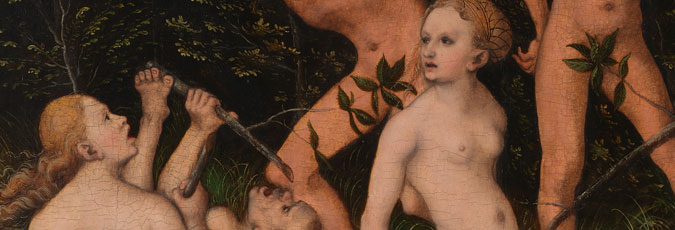Technical notes
Conservation
The picture was cleaned and restored in 1963. At the same time a cradle was removed from the back of the panel and the support reinforced with balsa and wax-resin.4
Condition
The paint is in reasonably good condition; there is a large loss in the top left corner and scattered losses elsewhere. The flesh is worn, especially in the dark areas.
Materials and technique
The support is an oak panel consisting of a single board of wood about 0.6 cm thick which is tangentially cut.5 The white ground is chalk. It continues to the side edges of the panel but at the top and bottom the ground and paint end just short of the edge with a slight 'barbe', leaving narrow strips of bare wood which would have been covered by an engaged frame.6 In places along these unpainted edges there are traces of ground where it seeped under the frame when it was applied. No canvas or fibre reinforcement between panel and ground can be seen in X-radiographs. There does not appear to be a priming layer over the ground.
Nothing that could definitely be identified as black underdrawing could be found with infrared reflectography. In most places simple outlining in the surface paint masks any underdrawing that might be present, although a few lines, for example in the the back of the head and legs of the standing female figure in the centre, may be underdrawing in black that was not exactly followed. Examination of the surface with a microscope, however, revealed lines of red pigment below the uppermost layers of paint. These red lines appear to be performing the role of underdrawing. It has not been possible to identify the red material used. The lines can only be seen where the paint over them is pale in colour and thinly applied. They have been found in many areas, notably along several contours of the figures, and in the landscape (figs 9 and 10).Where red lines were found they were less close to the final composition than the black lines mentioned above and so were probably drawn first.
Medium
Heat-bodied linseed oil was detected by GC–MS analysis in samples taken from the green paint of the foliage and in samples of blue and white paint taken from areas of the sky.
Pigments
Looking at the surface of the painting with a stereomicroscope, and at the paint cross-sections taken during cleaning in 1963, it is evident that the artist has underpainted the background, but not the figures, with varying shades of grey. In a sample from the green grass, this underpaint has a mid-grey tone and consists of lead white mixed with charcoal black and a little vermilion. In some places it can be seen to be thinly applied and streaky, for example in a small area at the right of the foreground where it is not completely covered by the green paint on top. Under the dark green of the background trees it is almost black, with just a little white and vermilion, and is again thin and streaky, as can be seen where it continues slightly beyond the foliage under the thin light grey rocks of the outcrop on the left. A similar thin dark paint is present under the blue parts of the sky and the distant mountains, rocks and buildings. The green paint is based on verdigris,7 with varying amounts of lead-tin yellow and lead white. In the sky a mixture of lead white, azurite and a little pale red lake has been used. The flesh paint is composed of a mixture of lead white, red lake (with red fibres indicating that it was prepared from dyed textile shearings), black pigment of large particle size, and vermilion. More of this last pigment is present in the ruddier flesh of the standing men than in the pale flesh of the women. In general, the paint is quite thinly applied, although with slight impasto for highlights on leaves, and the small spots of white lichen on the trunk and branches of the trees at the left. In places it has been worked wet-in-wet, for example where it has been feathered to soften the contour at the edge of the central rock.
Further sections
- Introduction
- Provenance, exhibitions, versions, and copies
- Technical notes
- Subject
- Attribution and date
5. Report by Dr Peter Klein of 8 March 1994 in the NG dossier. The tangential cut of the wood precludes dendrochronological dating.
6. At this period it is also possible that temporary slotted wooden battens were in place top and bottom when the ground was applied, rather than a permanent engaged frame.
7. Verdigris was identified by ATR–FTIR imaging.

